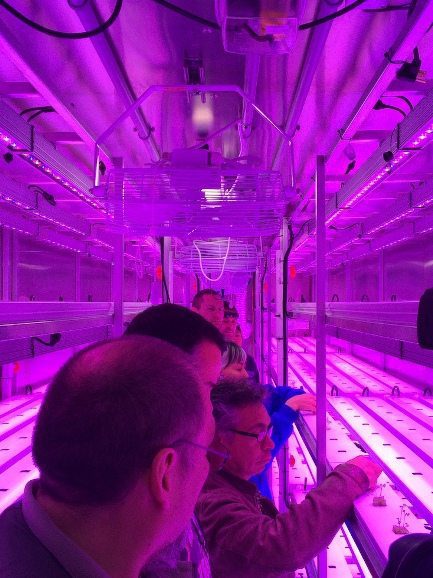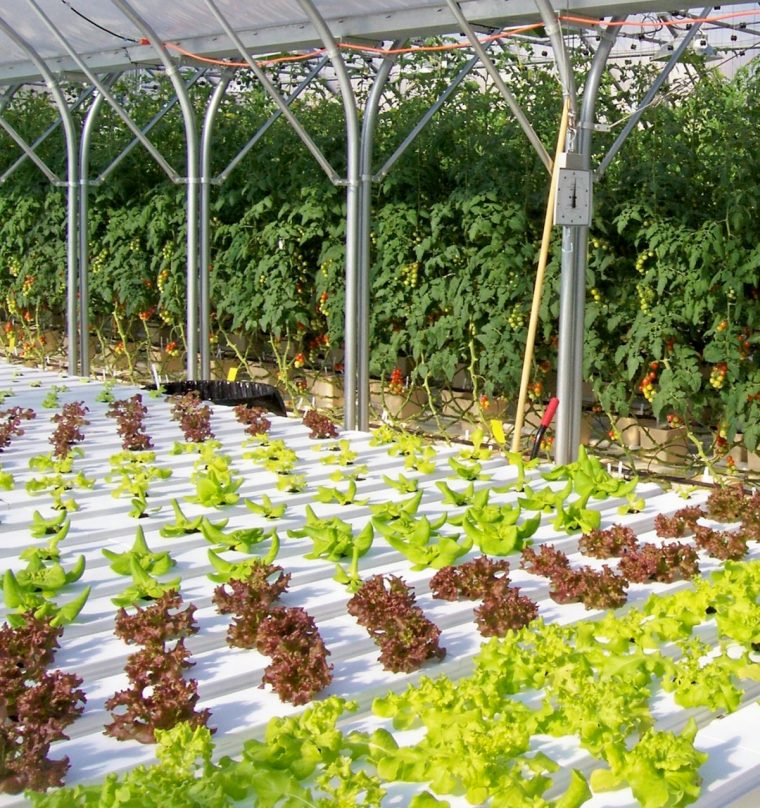While hydroponic farming may already be well established north of the Arctic Circle in some countries, it’s a pretty novel thing in Alaska. Most surprising, given that over 90% of the food in Alaska is transported thousands of miles from California and Mexico, which means truly fresh fruits and vegetables don’t exist there once the short summer gardening season is over. Imagine what a head of lettuce looks like after steaming into the Port of Anchorage followed by a long drive or even a plane ride to settlements and small towns scattered across the tundra.
No doubt there are people dabbling in growing their own in hydroponic systems here and there at home, but growing fresh food locally for market year around? At first glance, it appears to just arrived there in 2016, though hyper local indoor farming is the solution to improving food quality and establishing food security in a land where population density is very low, settlements are widely spread apart, winter is long and brutal – and in some cases, the only method of produce arriving is by sled, water, or air.

KIC board members plant their first hydroponic farming crop in Kotzebue (Vertical Harvest)
The most recent hydroponic farming to take root is a shipping container growing facility installed in late May to provide fresh lettuces, greens, and herbs to the 3200 people living in Kotzebue, 80% of which are native Inupiat, who still rely on hunting and fishing for food just as they have for hundreds of years. The city sits 33 miles north of the Arctic Circle in the Northwest Arctic Borough (population 7,752). There are several other communities around the Kotzebue Sound, but Kotzebue is the largest. No doubt those enticing fresh greens will attract others from smaller settlements in the area, especially with climate change threatening their ability to live off the land and sea. And it’s not like they can hop in a car or truck and travel an hour or two to a large city where better shopping is available. It looks like the only way to get to Nome, Fairbanks, or Anchorage is to fly. Google Maps can’t provide driving directions; the only roads end at the edge of town.
As remote Alaskan Inuit settlements go, Kotzebue is a happening place with a radio station, and a weekly paper that covers all of Northwest Arctic Borough, and neighboring North Slope Borough. It’s the hub for native health and social services in the borough, providing telemedical support for Community Health Assistants in outlying villages through the tribally-operated Maniilaq Association Health Center. And now a new company called Arctic Greens is making history there growing hyper local fresh food with state of the art technology. The hydroponic farming business is a new subsidiary of the Kikiktagruk Inupiat Corporation, whose COO, Jeff Hicks, told KNOM Radio in an interview on June 9th:
“Mizuna, mustard, and watercress… We have spinach, kale, red lettuce, green lettuce, and butter head lettuce. We have basil, cilantro, and several other different kinds of herbs.”
They can grow 45 different hydroponic crops, but once the indoor farm is is fully up and running, they’ll be able to deliver 450 heads of locally grown produce a week – year around. If the one freight container operation proves as successful as they believe it will be, Arctic Greens will be expanded, giving them growing capacity to feed people in communities at greater distances from their Kotzebue base. It’s all quite new to them at the moment, with their inaugural crop freshly planted, and becoming interested in it just last fall after talking to the new shipping container hydroponic facility builder, Vertical Harvest, also a new Alaskan company from Anchorage.
While checking it all out initially last year, Hicks bought 4 heads of lettuce from Vertical Harvest’s farm, which he lost no time in showing to manager at the AC store in Kotzebue, the local grocery store owned by Alaska Commercial Company. Needless to say, the AC store is very interested in stocking produce that fresh as soon as it’s available, and Hicks already has tentative plans to place more hydroponic farms in other communities once this pilot installation proves successful.
At the beginning of the year, Vertical Harvest and Alaska Natural Organics were vying for the title of the first businesses to open hydroponic farming companies in Anchorage. I never did get to the bottom of which one was actually first, but there is plenty of room for both of them and more competitio with a population of about 300,000. The perfect customer for Vertical Harvest’s retrofitted 40-foot shipping container farms are communities spread so far apart in the northern areas of the state, especially those only reachable by plane, because sending fresh produce to them in the cold months is almost impossible – the temperatures cause it to freeze at the airport. Meanwhile, Alaska Natural Organics is building a large farm operation in a long vacant dairy warehouse in Anchorage.

Hydroponic farming stacks at Alaska Natural Organics in midtown Anchorage (KTVA 11 screenshot)
Alaska Hydroponic Farming Pioneers
Truth be told, the first hydroponic farming being done in Alaska was under glass in the very forward thinking settlement known as Chena Hot Springs, a community and resort focused on self-sustainability. Indoor growing here began in 2005 as experimental using geothermal heated water from the hot spring fed lake that never freezes. The research showed they could maintain the perfect temperature for plants to thrive in despite outdoor temps ranging from 80F in summer to -56F in winter. In 2006, they developed geothermal energy production allowing the resort community to get rid of the generators that provided power to their remote location 56 miles northeast of Fairbanks.
Dubbed Chena Fresh, it is the northernmost commercial greenhouse in the U.S. operating year around. With the small 1000 sq. ft. greenhouse successfully providing a growing environment over 156 degree natural temperature range outdoors, in 2010 two gutter connect poly houses were added to launch hydroponic farming in 2 separate environments for different crop requirements. Today, Chena Fresh pumps out an amazing amount of fresh, locally grown food for humans and animals in the land of the midnight sun with nothing between the crops and the brutal natural climate but a poly cover wall. All crops are grown under crop-specific LED fixtures in winter when there is no sun.
“Chena Hot Springs Resort produces on-site hydroponic lettuce, greens, tomatoes, herbs, fodder (animal feed), and small fruits for the restaurant, employee meals and livestock. More than 500 heads of lettuce a week, and annually 25,000 lbs of tomatoes, 275 tons of fodder, and 400 lbs of zucchini is produced in the 6000 ft2 year-round controlled environment geothermally heated greenhouse, 2178 ft2 high tunnel, and 192 ft2 fodder system.” — Chena Fresh Fact Sheet

The first hydroponic farming operation in Alaska… Chena Fresh greenhouses.
A very interesting place! Situated south of the Arctic Circle line, but it’s not very far away. How far? A skosh, I can’t locate a distance measurement. Follow the link in the list below to get all the details on the development of their hydroponic farming operation, and investigate their other self-sustainability research. The resort is open year around.
More Info: